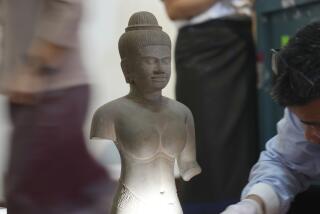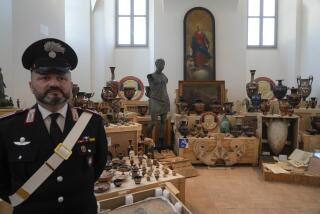Getty makes new offer to Italy
- Share via
The J. Paul Getty Museum agreed Tuesday to return 26 antiquities to Italy but declared an end to negotiations with Italian officials over 20 other objects, citing an unacceptable ultimatum.
The Getty also offered to transfer title of its prized statue of Aphrodite to Italy while both sides continue to investigate its origin, but refused Italy’s insistence that any deal include a 2,500-year-old statue, a bronze figure of an athlete -- one of the hallmarks of the museum’s collection.
Meanwhile, as talks broke down with Rome, the Getty faced a new legal challenge in Greece.
A prosecutor in Athens announced he had recommended that criminal charges be filed against five people in connection with an ancient funerary wreath allegedly looted from the country.
One of the five, according to a senior Greek official, is Marion True, the Getty’s former antiquities curator.
The developments, which came in quick succession after months of slow progress, marred what the Getty had hoped would be a celebrated decision to relinquish objects that museum officials concluded were removed illegally from Italy.
“It’s a shame it’s not the joyous occasion it could be,” said Michael Brand, the museum’s director since January, calling the planned return a “very, very important step.”
Italian cultural officials could not be reached for comment Tuesday about the Getty’s announcement.
It was not immediately clear whether they would accept the museum’s offer to return some, but not all, of the disputed items. In the past, they have said they wouldn’t settle for anything less than all 46 objects that they allege were looted.
Earlier this month, the officials threatened to impose a cultural embargo on the museum, preventing it from drawing on Italy’s academic and artistic resources for scholarship and exhibits unless the Getty honored their demands for repatriation.
Talks had already been complicated by the ongoing criminal prosecution of True, who stands accused in a Roman court of trafficking in looted art.
But the breakdown came over the so-called Getty Bronze, the figure of the athlete first admired by J. Paul Getty himself and acquired by the museum soon after the philanthropist’s death in 1976.
The statue was found by Italian fishermen in international waters and spirited out of the country before it was bought by the Getty, which today displays it in its own humidity-controlled room at the newly renovated Getty Villa.
Italy has acknowledged that it has no ownership claim because the statue was found at sea, but officials say the statue should be returned because it was illegally exported.
The Getty has refused, and released a lengthy report Tuesday explaining why the Italian evidence was insufficient. The report said the law does not require the return of the statue solely on the grounds of export violations.
“From a legal point of view, I think the Getty is correct,” said Patty Gerstenblith, a legal expert on cultural property disputes at DePaul University in Chicago. “From an ethical stance, it’s more complex.
“I think the Italians have to be careful about not going too far with it,” she said. “I think public sympathy is with the Italians for now, but they have to be careful not to overreach.”
In Athens, the city’s chief prosecutor had concluded an initial investigation into another masterpiece of the Getty’s antiquities collection: a golden funerary wreath, an ornate weave of solid gold stems and leaves studded with colored glass.
According to a news release, the prosecutor recommended that three foreigners and two Greek citizens be charged with looting, selling and receiving the funeral adornment.
The release did not name the individuals involved and said only that the object was purchased by a “private American museum” in 1993 for $1.15 million. But a senior Greek official familiar with the case identified the Getty as the museum and said True was among the five individuals.
Under the Greek system, the case will now go to an investigating magistrate, who will conduct his own inquiry, which could take weeks or months.
Neither the Getty nor True’s American attorney in Los Angeles, Harry Stang, would comment on the development.
The Greek announcement comes amid negotiations between the Getty and officials from the Hellenic Ministry of Culture over the return of the wreath and a statue of a female torso.
Among the 26 objects the Getty agreed to return to Italy are several other masterpieces now on display, including a 300 BC marble sculpture depicting two mythical griffins; a 300 BC ceremonial water bowl with a scene on its interior of sea nymphs bearing the weapons of Achilles; and a marble statue of Apollo dating to AD 100. Italian authorities have presented Polaroids of the objects during True’s ongoing trial showing the objects in pieces and covered in dirt.
A 1985 internal Getty memo, first revealed in The Times last year, said “excavators” found the pieces in tombs in Italy’s Taranto region during the late 1970s, when such activities were illegal.
In a letter dated Monday to Italy’s cultural minister, Brand wrote that returning the 26 pieces “is the right thing to do,” although they “will be sorely missed by the museum and its visitors.”
The letter also acknowledged that the museum could have been more careful while building its collection.
“In retrospect, the Getty should have gone further to minimize the possibility of acquiring objects that had been obtained in violation of foreign cultural patrimony laws,” Brand wrote.
“But we reject any suggestion that the Getty had knowledge when it acquired the objects to be transferred that they had been illegally excavated from Italy.”
Brand concluded his letter by leaving the door open to future talks if the Italians think it would be “productive.”
“In the end we are not separated by much ground, but unfortunately we can give no more,” he wrote.
The impasse comes five months after the Getty and Italy announced a deal in which the museum agreed to return “a number of very significant” Greek, Roman and Etruscan antiquities. In return, the Italians pledged to lend objects “of comparable visual beauty and historical importance.”
The pact appeared to end years of recrimination and denials over Italian accusations that the Getty, more than any other American museum, had filled its collection with illicit antiquities.
Yet as the sides dug in over the specifics, the truce fell apart.
While the Italians pressed demands for all of the objects, the Getty believed that officials had reneged on the previous agreement to accept a number of the antiquities, continue talking about the rest and offer cultural cooperation.
The Italians believed the Getty was stalling because it feared that returning more objects would jeopardize True’s criminal defense.
Both sides cite recent concessions in their negotiating positions. Italy agreed to renounce its claim to six disputed objects. The Getty recently announced a new, stricter acquisition policy and proposed what it called a “creative” solution for sharing title for the statue of Aphrodite for four years while investigations continued.
Italian officials rejected that offer and began discussing a cultural embargo if progress was not made.
Brand and two of the Getty’s outside attorneys flew to Rome last week to discuss “a final offer” in which the Getty would transfer full title for the statue while both parties pursued a joint investigation to decide where the Aphrodite belonged.
“In my mind, that was more than fair,” said Ron Olson, one of the Los Angeles attorneys who accompanied Brand. “It was generous and it was rejected.”
Olson said Italian Cultural Minister Francesco Ruttelli made it clear there would be no deal unless the Getty gave back the bronze. “They gave us a non-negotiable demand for the bronze, and we’re not crossing that line,” Olson said. “We were told in no uncertain terms that unless there is a transfer of both the bronze and the Aphrodite, there will be no deal.”
Times special correspondent Nikolas Zirganos contributed to this report from Athens.
More to Read
The biggest entertainment stories
Get our big stories about Hollywood, film, television, music, arts, culture and more right in your inbox as soon as they publish.
You may occasionally receive promotional content from the Los Angeles Times.










